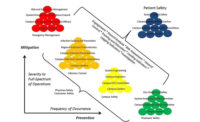The global pandemic has presented unforeseeable challenges to millions of our nation's workers, or Industrial Athletes. In a normal year, global labor statistics estimate that nearly 39,000 of these vital workers are injured on the job every hour worldwide and an estimated 5,250 will die as the result of a workplace injury in the United States alone, according to OSHA.
This, however, is not a normal year.
While keeping workers safe has always been our singular goal, we must now ask ourselves how we as businesses can serve the world’s workers as they work longer and harder than ever before in the age of COVID-19.
How COVID-19 Is Impacting Risk
Having dramatically increased the workload while simultaneously taking many Industrial Athletes out of commission, the pandemic’s effects have wreaked havoc for workers. Increased workload puts more strain on their bodies, subsequently increasing the likelihood of physical injury.
Most companies combat “peak” seasons like this — consider the holiday retail rush that occurs between November and January — with rotational changes to staffing and shift structure. This particular increase in demand came completely out of the blue. Unlike a “peak” season that can be planned months in advance, COVID-19 left workers, and managers, with a barrage of new obstacles and very little insight into getting past them.
The biggest new risk involved, of course, is transmitting the virus to others or becoming ill with COVID-19 yourself. Employers who are deemed essential are fighting a battle to keep their workers safe — not only because worker safety is paramount, but because a major localized spread of the virus within a facility could cause the operation to shut down. Even a temporary cessation of operations could prove detrimental from a business standpoint.
In conjunction, employers are trying to make sense of new state and federal regulations related to the pandemic. If a business has a warehouse in every state, for example, and each state’s laws about social distancing guidelines, recording temperatures, wearing PPE, and disinfecting facilities are different, that is a huge amount of regulation to digest and act upon expeditiously.
That said, anecdotal evidence suggests the number one new challenge from an Industrial Athlete’s perspective is maintaining social distancing guidelines within facilities. With so much going on at once, it can be difficult not to fall back into old habits when getting into the routine of work, and the “six feet apart” rule can sometimes fall by the wayside. Most workers are used to operating in close proximity to each other and the machinery, so it is not uncommon for them to unconsciously disregard these rules. And while exhaustion from increased work hours may also play a factor, it is laborious and time-consuming for employers to constantly reiterate and reinforce social distancing measures.
Putting Workers In the Spotlight
To put it all into perspective, according to our data, Industrial Athletes right now are working at nearly double the rate of a typical “peak” holiday retail season. As we process millions of hours of workplace data from this new reality, we are reminded more and more every day that workers power the world around us.
From stocking the shelves of grocery stores, getting packages to your doorstep, or manufacturing the supplies we need daily, industrial workers are the ones who built the world we live in, and COVID-19 is forcing the world around us to realize that. We are often removed from the reality of the strain these people are placing on their bodies, but it is incredibly important to bring attention to their sacrifice.
Pioneering the Solution
Since analyzing the data tells us just how much harder Industrial Athletes are currently
working, we as an industry have to do more than be troubled by the problem; we must be obsessed with finding the solution. We don’t yet know the extent of injury rates as a result of the tremendous new pressure placed on these critical frontline workers.
But we do know this: Right now, in every corner of the country, tens of thousands of employees are being hired to heed the call, and the expectations are staggering — logging more shifts, putting in more hours, working harder and harder to supply the country with what it needs. Their service has allowed us to retreat into our homes and keep ourselves safe, so we must continue placing their safety at the heart of everything we do.
While we’re incredibly proud of preventing ergonomic workplace injuries at scale, we’re also now forced to shift focus to the “new normal.” COVID-19 has altered the profile of workplace risk forever; it’s our job — along with many incredible partners — to pioneer the processes, the technology, and the culture that will ensure no worker is ever left behind as a result. We are doing just that.



